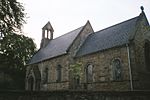Durham Priory

Durham Priory was a Benedictine priory associated with Durham Cathedral, in Durham in the north-east of England. Its head was the Prior of Durham. It was founded in 1083 as a Roman Catholic monastery, but after Dissolution of the Monasteries in 1540 the priory was dissolved and the cathedral was taken over by the Church of England. Historically, Durham Priory was one of the most important land owners in County Durham along with the Bishop of Durham until the Dissolution of the Monasteries by Henry VIII. Until then, Durham Priory was home to between 50 and 100 Benedictine monks. Durham was the largest and richest of the monasteries associated with Durham; the other cells were in Coldingham Priory (until 1462), Jarrow and Monk Wearmouth, Finchale, Farne, Holy Island, Lythe, Stamford and Durham College, Oxford (after 1381). The Bishop of Durham was the temporal lord of the palatinate, often referred to as a Prince-bishop. The bishop competed for power with the Prior of Durham who held his own courts for his free tenants. An agreement dated about 1229, known as Le Convenit was entered into to regulate the relationship between the two magnates.After the Benedictine monastery was dissolved, the last Prior of Durham, Hugh Whitehead, became the first dean of the cathedral's secular chapter.Durham Priory held many manuscripts; in the 21st century, steps were under way to digitise the books, originating from the 6th to the 16th century, owned by the Benedictine monastery. The project was being undertaken in a partnership by Durham University and Durham Cathedral.
Excerpt from the Wikipedia article Durham Priory (License: CC BY-SA 3.0, Authors, Images).Durham Priory
Durham Viaduct
Geographical coordinates (GPS) Address Nearby Places Show on map
Geographical coordinates (GPS)
| Latitude | Longitude |
|---|---|
| N 54.77321 ° | E -1.57683 ° |
Address
Durham, Viaduct
England, United Kingdom
Open on Google Maps










